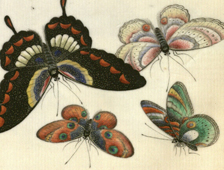In our rare book collection is a little silk-covered album containing twelve plates of brilliantly colored butterflies painted on pith paper. (Chinese plates of butterflies) Made in China in the mid-1800s, it is a beautiful example of what is called China trade art, which became a flourishing market in the aftermath of the Opium War when China had to cede its ports to the West. Albums like these were very popular with American and British merchants who brought them back home as souvenirs, although very few of them survived intact, as most were disbound so that the plates could be framed. (Just check ebay to see some.) Many albums depicted daily life in China, trades, peoples, court life, but a few very purely decorative, like ours, showing butterflies that only remotely resemble real creatures.

Our album was featured in Natural histories: extraordinary rare book selections from the American Museum of Natural History Library (2012), and in preparation for the essay about it, I sought other copies in the New York area, in vain. So, imagine my surprise when strolling in Rockefeller Center last week, I stumbled across the window of the Metropolitan Museum gift shop and saw our butterflies reproduced on a decorative panel! I immediately mentioned this to Tom Baione, our library director, who arranged for the two of us to see the copy held by the Museum-across-the-park. Yes, they are very similar, and yet different in many ways. Not surprising as such albums were produced continuously over several decades by artisans working chain-style on sections of illustrations, never being solely responsible for any single plate. Our album includes only butterflies, but the Met’s has other insects and even a lizard. Their images seem to be less detailed and may have been created at a later date.
We plan to digitize our plates in the near future, and it would be interesting to create a mini-database of other such examples, perhaps shedding light on the historical development of the art form and the anonymous artists who created them. Do you have any?
- Diana Shih, Assistant Director Bibliographic Records Management